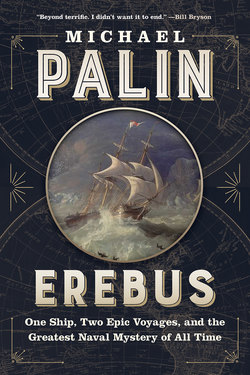Читать книгу Erebus - Michael Palin - Страница 9
На сайте Литреса книга снята с продажи.
ОглавлениеPROLOGUE
THE SURVIVOR
Wilmot and Crampton Bay, Nunavut, Canada, 2 September 2014. Near the coast of a bleak, flat, featureless island, one of thousands in the Canadian Arctic, where grey skies, sea and land merge seamlessly together, a small aluminium-hulled boat called the Investigator is moving slowly, carefully, rhythmically across the surface of an ice-blue sea. Towed behind her, just below the water-line, is a slim silver cylinder called a towfish, not much more than 3 feet long. Inside the towfish is an acoustic device that sends out and receives sound waves. The sound waves bounce off the seabed, are returned to the towfish, transmitted up the tow-cable and translated into images of the seabed below.
There is not much noise on the Investigator, save for the monotonous drone of her engines. The weather is quiet, the skies clear and a watery sun is shining onto a glassy-calm sea. Everything is muted. Time is passing, but that’s about all.
Suddenly there’s a commotion: the towfish has narrowly missed hitting a shoal; the attention of everyone on board switches to making sure their expensive sonar device is safe. At that moment Ryan Harris, a marine archaeologist, casting a brief glance at the screen before going to help, sees something other than sand and stones on the seabed. Something that brings him up sharply.
On the screen is a dark shape: something solid and unfamiliar, lying right there on the shallow seabed, only 36 feet below him. He shouts out. His colleagues crowd around the computer screen. He points to the shape. They can barely believe what they see: below the Investigator’s silver towfish, indistinct in detail but unmistakably clear in shape, is a wooden hull. It’s broken at the stern as if a bite had been taken out of it, the deck beams are exposed, and all is covered in a woolly coat of underwater vegetation. What they are looking at is a ship. A ship that disappeared off the face of the earth, along with all her crew, 168 years ago. A ship that had one of the most extraordinary lives and deaths in British naval history – and, from this day on, one of the most remarkable resurrections.
She stands proud, so close to the surface that at one time her two tallest masts would have peeked out above the waves. Her hull is solid, apart from some impact-collapse at the stern. Strands of kelp, a large brown algae, cover the outlines of the timberwork like loose-fitting bandages. Her three masts have broken off, as has the bowsprit. Pieces of them lie in the nest of debris scattered around her. Amongst the wreckage, half-sunk in the sand, are two of her propellers, eight anchors and a segment of the ship’s wheel. Her three decks have, in some places, fallen in on each other. Many of the main beams that run across the ship appear still to be strong, though the planking above them is mostly stripped away, giving her the appearance – when seen from above – of a half-filleted fish.
A massive cast-iron windlass stands, undamaged, on the upper deck. Nearby are two copper-alloy Massey pumps. Some skylights and the Preston Patent Illuminators that would have given light to the men below are well preserved.
The lower deck, where the life of the ship would have gone on, lies exposed in places, still covered in others. Chests where seamen kept their belongings, and on which they sat at meals, can be made out under the accumulation of silt and dead kelp. There are numbers on the deck beams to mark the positions where hammocks would have been slung. Ladderways and hatches giving access to the decks above lie open and ghostly. The galley stove, on which meals would have been prepared, is intact and in position. In the bows, the outlines of the sickbay can be made out.
Further aft, portions of the captain’s cabin, the mess room and several of the officers’ cabins are distinguishable through a jumble of collapsed timbers. In one of them is a bed-space, with drawers beneath. The transom – the stern wall of the ship – has suffered most damage, but the captain’s bed cabin next to it is in place, as are lockers and a heater. The orlop deck, the lowest of the three, is least damaged, but also the most difficult to penetrate. A shoe, mustard pots and storage boxes have nevertheless been retrieved. Divers have also recovered a set of willow-pattern plates, the stem of a wine glass, a ship’s bell, a bronze six-pounder cannon, various decorated buttons, a Royal Marines shoulder-belt plate embossed with a crowned lion standing on a crown, and a thick glass medicine bottle with the name ‘Samuel Oxley, London’ embossed on the sides. It originally contained a potion made by Oxley from concentrated essence of Jamaican ginger. He claimed it as a cure for ‘Rheumatism, Indigestion, Windy Complaints, Nervous Headaches and Giddiness, Hypochondria [I love the idea of a medicine for hypochondria], Lowness of Spirits, Anxieties, Tremors, Spasms, Cramp and Palsy’. This all-too-human cure-all remains, for me, one of the most poignant finds on HMS Erebus. A reminder that epic adventures and everyday frailties go hand-in-hand.
For 80 per cent of the year the ice freezes and seals in the ship’s secrets again. But when it melts, people like Ryan – who has made more than 200 dives – along with the rest of the underwater team, will be back in the water looking for many more precious details. My dream would be to get to know Erebus as intimately as they have done. Just once. What I need is Hooker’s wetsuit.
Two contemporary plans showing (above) a typical bomb ship in profile, and (below) the orlop (or lower) deck and hold of Erebus and her sister ship Terror.
